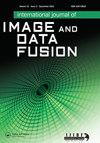Boosting the multiple aircraft online tracking performance via enriching the associated data with fused targets features
IF 1.8
Q3 REMOTE SENSING
International Journal of Image and Data Fusion
Pub Date : 2021-07-19
DOI:10.1080/19479832.2021.1953621
引用次数: 2
Abstract
ABSTRACT Multi aircraft tracking from an aerial view is a backbone for several military and civilian applications. Recent tracking by detection approaches was utilized to accomplish such multiple target tracking (MTT) tasks as Simple Online and Real-time Tracking (SORT). SORT is a strong and fast MTT, that employs a Kalman filter for the target motion parameters and the Hungarian method for the data association. But it discards the target appearance for resolving the association problem to preserve the real-time execution which results in increasing the number of (IDS) Identity Switches and decreasing the tracking accuracy. In this work, the target appearance information is incorporated alongside its geometry to leverage the tracking accuracy and reduce the tracklet fragments due to the high number of IDS. The target shape and contextually based feature of Histogram orientation of Gradient (HOG) are combined with its color histogram to enrich the Hungarian association with the appearance information. A recent-released multi-aircraft data set is utilized to examine the proposed improvement through a comparative experiment that reveals the MTT performance-boosting while keeping the real-time execution. The proposed method reduces the tracked targets IDsw by 60.97% that improves the tracker overall accuracy by 8.6% compared to the SORT tracker.通过融合目标特征丰富相关数据,提高多机在线跟踪性能
摘要:多机空中跟踪是多种军事和民用应用的支柱。最近的检测跟踪方法被用来完成诸如简单在线和实时跟踪(SORT)之类的多目标跟踪(MTT)任务。SORT是一种强大而快速的MTT,它对目标运动参数采用卡尔曼滤波器,对数据关联采用匈牙利方法。但它放弃了用于解决关联问题的目标外观,以保持实时执行,这导致增加了(IDS)身份开关的数量,降低了跟踪精度。在这项工作中,将目标外观信息与其几何形状结合在一起,以利用跟踪精度,并由于IDS的数量众多而减少小轨迹碎片。梯度直方图方向(HOG)的目标形状和基于上下文的特征与其颜色直方图相结合,以丰富匈牙利与外观信息的关联。利用最近发布的多机数据集,通过比较实验来检验所提出的改进,该实验揭示了MTT性能的提高,同时保持了实时执行。与SORT跟踪器相比,所提出的方法将被跟踪的目标IDsw减少了60.97%,从而将跟踪器的总体精度提高了8.6%。
本文章由计算机程序翻译,如有差异,请以英文原文为准。
求助全文
约1分钟内获得全文
求助全文
来源期刊

International Journal of Image and Data Fusion
REMOTE SENSING-
CiteScore
5.00
自引率
0.00%
发文量
10
期刊介绍:
International Journal of Image and Data Fusion provides a single source of information for all aspects of image and data fusion methodologies, developments, techniques and applications. Image and data fusion techniques are important for combining the many sources of satellite, airborne and ground based imaging systems, and integrating these with other related data sets for enhanced information extraction and decision making. Image and data fusion aims at the integration of multi-sensor, multi-temporal, multi-resolution and multi-platform image data, together with geospatial data, GIS, in-situ, and other statistical data sets for improved information extraction, as well as to increase the reliability of the information. This leads to more accurate information that provides for robust operational performance, i.e. increased confidence, reduced ambiguity and improved classification enabling evidence based management. The journal welcomes original research papers, review papers, shorter letters, technical articles, book reviews and conference reports in all areas of image and data fusion including, but not limited to, the following aspects and topics: • Automatic registration/geometric aspects of fusing images with different spatial, spectral, temporal resolutions; phase information; or acquired in different modes • Pixel, feature and decision level fusion algorithms and methodologies • Data Assimilation: fusing data with models • Multi-source classification and information extraction • Integration of satellite, airborne and terrestrial sensor systems • Fusing temporal data sets for change detection studies (e.g. for Land Cover/Land Use Change studies) • Image and data mining from multi-platform, multi-source, multi-scale, multi-temporal data sets (e.g. geometric information, topological information, statistical information, etc.).
 求助内容:
求助内容: 应助结果提醒方式:
应助结果提醒方式:


